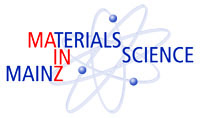Fehler beim Abrufen der XML-Daten!
Fehler beim Abrufen der XML-Daten!
Zum Physikalischen Kolloquium Mainz
Liste der laufenden Seminare und Kolloquien
| Veranstaltungstitel | Termin und Ort | Koordinator |
|---|---|---|
| Institutsseminar Kern- und Hadronenphysik | Montags, 1415 Uhr, HS Kernphysik, Becherweg 45 | Prof. Dr. Michael Ostrick |
| Seminar Festkörper- und Grenzflächenphysik | Dienstags, 1200 Uhr, Newton-Raum, Staudingerweg 9, 1. Stock, Raum 122 (Nebengebaeude) | Prof. Dr. Hans-Joachim Elmers |
| Seminar über Theorie der Kondensierten Materie/ Weiche Materie und Statistische Physik |
Freitags, 1030 Uhr, Newton-Raum (LG 01-122) | F. Schmid P. Virnau |
| Theory of Condensed Matter: Hard Condensed Matter | Tuesday, 1000 Uhr, Seminarraum K | Prof. Dr. Jairo Sinova |
| Theorie Palaver | Dienstags, 1430 Uhr, Lorentz-Raum (05-127) | Upalaparna Banerjee Federico Gasparotto Pouria Mazloumi Yong Xu |
| Physikalisches Kolloquium Mainz | Dienstags, 1615 Uhr, HS Kernphysik, Becherweg 45 | Prof. Hartmut Wittig Prof. Alfons Weber |
| PRISMA Colloquium | Mittwochs, 1300 Uhr, Lorentz-Raum (05-127) | Prof. Dr. Tobias Hurth |
| Quantengravitation-Seminar | Donnerstags, Sozialraum der THEP; Institut fuer Physik (05-427). | Prof. Dr. M. Reuter |
| Theoriekolloquium | Donnerstags, 1600 Uhr, Newton-Raum (LG 01-122). | Prof. Dr. P.G.J. van Dongen Jun.-Prof. Dr. J. Marino |
| QUANTUM-Seminar | Donnerstags, 1415, Lorentz-Raum (05-127) | Prof. Dr. Peter van Loock Dr. Lars von der Wense |
| Seminar experimentelle Physik der kondensierten Materie | Donnerstags, 1400, Minkowski-Raum, 05-119, Staudingerweg 7 | Univ-Prof. Dr. Jure Demsar Univ.-Prof. Dr. Hans-Joachim Elmers Univ.-Prof. Dr. Mathias Kläui Univ.-Prof. Dr. Thomas Palberg |
| Seminar zu Themen in der Collider-Physik | Freitags, 1230, Sozialraum ThEP (05-427) | Riccardo Bartocci Prisco Lo Chiatto Nicklas Ramberg Miroslava Mosso Rojas |
| MAINZ lecture series | Mittwochs, 915, Staudingerweg 9, 3. Stock, Raum 122 | Dr. M. Weides |
| Excellence@WORK | XXXXX,XXXX | Katrin Klauer |
| Seminar about Experimental Particle and Astroparticle Physics (ETAP) | Montags, 1215, Staudingerweg 7, 5. Stock, Minkowski-Raum 119 | Dr. DB. Ta |
Weitere Veranstaltungen
| Quantum Sonderseminar | Seminarraum Quantum (02-427) | Prof. Dr. Ferdinand Schmidt-Kaler |
|
Technische Wartung: ducbao.ta (klammeraffe) uni-mainz.de |


